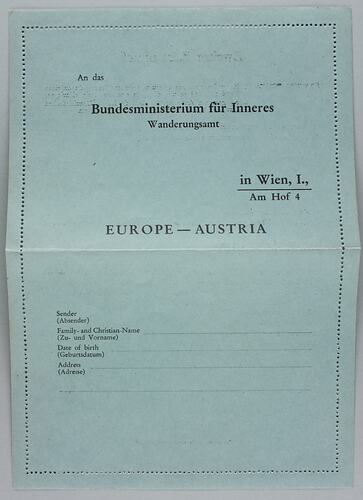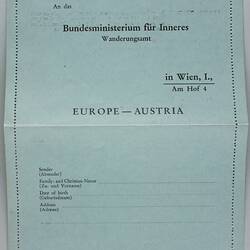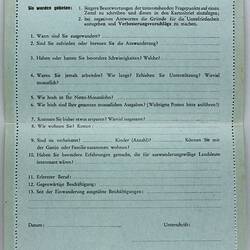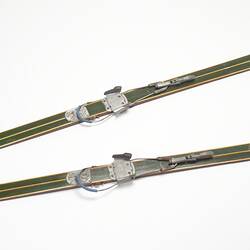Summary
Blue form entitled 'Erster Kartenbrief' ['First Letter Cards'], issued by the Austrian Federal Ministry for Interior, Immigration Office. It was issued to Dorothea Huber [nee Freitag and later Dunzinger] prior to her departure on her migrant voyage from Austria to Melbourne onboard the Cogedar Line ship 'Flaminia' in November 1959. It appears to be a questionnaire requesting feedback from people regarding their experiences in camps, the journey, training, any difficulties encountered, residential costs, marital and family status. This form has not been completed.
Born in 1929 near Graz, Austria, Dorothea Dunzinger [formerly Huber and nee Freitag] was a proficient recreational skier and part of a volunteer rescue team in Switzerland. She lived and worked primarily as a mill weaver and seamstress in England, Switzerland and Austria before migrating to Australia from Austria on 30 November 1959, arriving on the Cogedar Line ship 'Flaminia' on 31 December. She settled in Melbourne and married fellow Austrian Johann Dunzinger whom she met at Broadmeadows migrant hostel. They had a daughter Caroline and lived in various Melbourne suburbs boarding and renting before building a home in Kalorama. The couple divorced in1978. Dorothea worked hard all her life, owning a boutique clothing shop in Camberwell at one stage but primarily as a textile outworker and factory worker trying to make ends meet. She died in 2001.
Physical Description
Single sheet of blue paper with text in English and German printed in black ink. Border is perforated and reverse side has a border of sticky gum for selaing the folded paper closed for posting. Top half of front page has mailing address, bottom half for sender details. Inside text is a questionnaire. The form has not been completed.
Significance
The Dunzinger Austrian Migrant Collection has evolved to become a rich group of objects which tell a particular story of an Austrian woman's post-war migration experiences, as well as broader contextual narratives relating to the variety of selection and management processes in place in Europe after World War II. These include references to Australian-specific organisations involved in migration management such as the Australian Migration Mission. Items explore the enthusiastic promotional activities of the Australian Government to encourage migration from the UK and Europe in order to populate Australia and build a workforce. Artefacts also relate to a significant Italian migrant ship of the period, the Cogedar Line 'Flotto Lauro'.
There is a also symbolic poignancy about the skis and the small sewing machine Dorothea Dunzinger brought with her from Austria: the skis representing precious mementoes from home and hopes and expectations for the leisure activity they might bring in Australia; the sewing machine a pragmatic object which came to dominate Dorothea's actual settled life of hard work both in the home and as an outworker with no leisure time at all.
More Information
-
Collecting Areas
-
Acquisition Information
Donation from Ms Caroline Dunzinger, 07 Nov 2012
-
Past Owner & User
-
Inscriptions
Cover: 'An das Bundesministerium fur Inneres/ Wanderungsant/in Wien, I., Am Hof 4/ EUROPE-AUSTRIA' Inside title: 'Erster Kartenbrief'
-
Classification
-
Category
-
Discipline
-
Type of item
-
Overall Dimensions - Open
150 mm (Width), 210 mm (Height)
-
Keywords
Austrian Immigration, Post War Migration, Migration & Settlement



